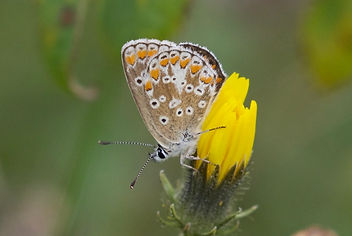
Blues (Lycaenidae)
An exquisite group of 9 butterflies, closely related to the Hairstreaks and Coppers. 2 species are all brown, as are the females of every species here, but the similarities to the blues are obvious. They vary greatly in population size and distribution but none are 'in your face'. They're mainly grassland butterflies, mostly found on limestone and chalk soils.
The photographs are arranged: Male upper-side, male underside, female upper-side, female underside.
Adonis Blue - This is a stunner. Very similar to the Common Blue but the blue is even more striking, usually described as electric blue. Whilst I'm pleased with these male images they still don't capture the ultimate shocking blue they can appear, in the right light.




BCS Rough Bank, Gloucs. August
Brown Argus - A modest little butterfly but if you get a close-up view they're equally stunning really. One of the more widespread.


Chalk Hill Blue - True to their name, these are chalk lovers. Slightly larger than the other blues, except perhaps the Large Blue, and a different shade of blue. More a milky or powder blue. Beautiful when freshly emerged.




NNR Aston Rowant, Oxon - Early August
Common Blue - It is true, this is the most common and widespread blue, as its name suggests. However they are still stunning. If you catch a freshly emerged male (like this one) you can't help but admire them.



Two female colour forms


Holly Blue - This is one you might be lucky enough to get in your garden, especially if you have holly and ivy present. They are a hedgerow and shrub specialist rather than grassland like most blues. Sadly they very rarely rest with their wings open. Pretty widespread this one though and probably the earliest blue.


Large Blue - A special butterfly that we lost in 1979, when it became extinct here. Thanks to some recent imported specimens from Sweden we now have several thriving small populations again, mainly in Somerset. The one site that is open to the public is Collard Hill. Two visits to date, one when breezy the other when rather cool, did not offer me the sight of an open winged butterfly, so I still have work to do. The upper wings are bright blue with black spots in the pattern of a dog's paw print.

NT Collard Hill, Somerset - June
Northern Brown Argus - Very closely related to the Brown Argos but this species prefers the cool of the North. They inhabit Cumbria northwards, whereas the Brown Argos is more of a nesh southerner.

NT Arnside Knott, Cumbria. August
Silver-studded Blue - Another stunning species. Very specialist, being dependant on ants to harbour their larvae and pupae. They are another mainly southern species. However we are lucky to have a colony in Shropshire, not too far from me. Once you find the colony, particularly at rest in the evening, you can get as close as you like for as long as you like. They are very docile and don't travel far either. Their colonies are often compact and they struggle (or don't bother) to extend their range. Heather lovers.


BCS Prees Heath, Shrops. July

Small Blue - This is the UK's smallest butterfly. Very cute and worth searching out. Most people will never notice them. They are a grassland/wild flower species and not that common. You need to find out where they are likely to be. These are freshly emerged examples. When they are older and the wings are worn they can look quite dull.


NT Rodborough Common, Gloucs. June